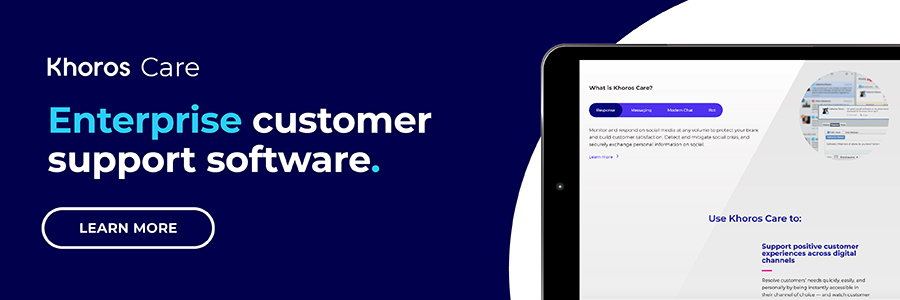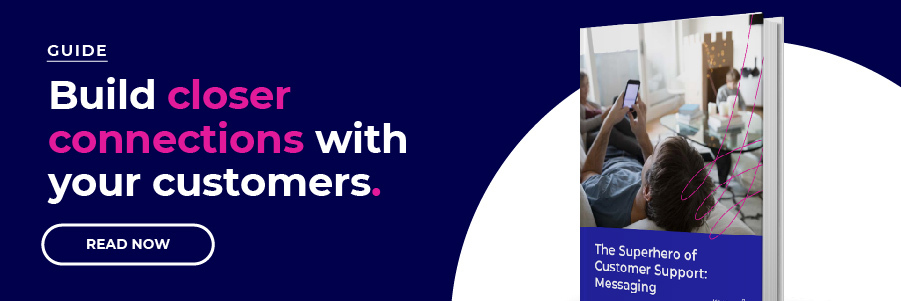 Logo
Logo
EXPERT INSIGHTS
Aug-06-2020
Heightened challenges for contact centers during COVID-19
Jackson Kushner
Contact centers are critical for handling the customer inquiries an enterprise brand regularly receives, and the service, and the quality and speed with which your contact center handles inquiries can make or break your customer relationships. In a recent Khoros survey, around 30% of customers said they would stop giving a brand their business if they did not meet the customer’s timeframe expectations.
Handling high volumes of inquiries is a large undertaking in normal circumstances, but as COVID-19 has increased support volume and created labor shortages at many contact centers, businesses are feeling the squeeze. Many brands operate contact centers with outdated technology, relying primarily on phone and synchronous, session-based chat.
These technologies have underlying flaws, and COVID-19 is exposing them. Here we’ll cover the top three challenges the pandemic has caused brands’ customer service departments — and the best way to solve them.
With a modern, digital platform to manage your contact center, you can solve these issues without adding unnecessary personnel or overhead.
1. Difficulty transitioning to remote work
Coronavirus forced many brands to quickly transition to remote work when they weren’t prepared to do so. This was a difficult hurdle for old contact center models, which rely on physical, on-premise systems that are difficult — or even impossible — to replicate for remote work. Agents can’t lug bulky phone systems or desktop computers to their homes, and this left contact center managers wondering what to do to maintain SLAs.
In addition to these logistical problems, contact center managers are also dealing with the real-life complications resulting from remote work.
Many support agents’ homes may not be well-suited for supporting phone or chat infrastructure. Unreliable internet access can cause them to drop calls or prematurely close out synchronous chat sessions. The lack of private or quiet space can make it impossible to take calls or maintain focus during spikes in inquiry volume. This can lead to poor customer service, but can also create additional problems for protecting customer and brand data. Interrupting children and pets, ill-suited workspaces, and mental health concerns are all potential complications of migrating on-site agents to mandatory remote work environments — and while some are worse than others, they all take a toll.
The contact centers who were best equipped to handle the rapid transition were the ones that had already taken advantage of modern, digital solutions. With capabilities like asynchronous chat and messaging, real-time agent performance tracking, and workforce management analytics, these digital solutions are equipped to handle the increased volume that comes with a crisis like COVID-19. And, importantly, they don’t require bulky on-premise hardware, so there’s almost nothing for agents to take home. This doesn’t just minimize risk for your brand; it also allows for greater flexibility in both transitioning and adapting to remote work.

2. Increased tension — for both customers and staff
The fallout from COVID-19 has added measurable stress to daily life. People are experiencing anxiety, economic strain, grief, and more — and this affects customers and agents alike.
Agents deal with their fair share of angry customers. However, recent high tensions have increased the rate at which care agents interact with such customers, with phone service agents bearing the brunt of this communication.
The increased stress of work due to these negative customer interactions, in addition to the stress that comes from living through a global pandemic, negatively affects care agents’ productivity and job satisfaction. This can lead to both inefficiencies and high turnover rates.
However, contact centers can improve both employee and customer satisfaction through digital-first customer service. Because brands that employ digital customer service systems deflect more calls to digital channels, their agents spend less time on the phone dealing with angry customers.
Conversations on digital channels that begin negatively are more likely to end positively than phone calls. For example, see how Khoros Care helped Swisscom turn 43% of dialogues that started out as negative and 42% of dialogues that started out as neutral positive during a technical outage.
Digital channels can also help brands reduce agent attrition. These channels often reduce the stress of messaging operations and provide more satisfactory work, improving agent satisfaction. This means less money spent on training new agents, as well as a more efficient contact center — both valuable sources of ROI.
3. Staff shortages and high inbound inquiry volumes
Unprepared contact centers are finding themselves short staffed in the wake of COVID-19. Some businesses have had to downsize their staff size due to economic pressures and others may be trying to operate with fewer agents per shift due to increases in illnesses and quarantine mandates. Employees now need to take longer periods of time off to take care of children or sick loved ones, or to properly recover and isolate after contracting COVID-19.
Contact centers are also experiencing substantially increased inbound inquiry volumes. With their current systems, phone-based operations are significantly limited in the number of inbound inquiries their care agents can satisfy within a timely manner. This is ultimately due to the inherent lack of practical scalability of call centers.
Digital customer service methods offer much greater efficiency than outdated methods, largely thanks to their ability to divert inbound calls to digital channels. Not only does this shorten customer service interactions, it also greatly increases the number of inquiries each agent can handle at one time. The convenience of non-session messaging makes agents more likely to resolve an inquiry in the first conversation, creating a higher first contact resolution (FCR) rate and generating fewer repeat inquiries than phone operations where poor connections, bad timing, and frustration cause higher dropoff. What’s more, messaging is more suitable for AI-powered automation (e.g., chatbots) than phone support, as customers are less likely to sit through voice-bot prompts than they are to interact with a chatbot to resolve their inquiry before reaching an agent.
Indeed, some businesses take advantage of digital customer service methods to move store staff into online and support functions. The ease with which employees can learn the software, as well as its mobility and adaptability, make this a relatively quick and inexpensive transition — and it can help businesses handle the changes that have come with COVID-19.

Khoros offers customer care solutions to underlying contact center problems
The flaws of traditional contact centers have been apparent for some time; however, COVID-19 has acted as a catalyst, exacerbating these flaws so much that they’ve become increasingly detrimental, perhaps even fatal, to businesses. The impractical scalability and reliance on physical systems of primarily phone-operated contact centers have made it difficult for brands to maintain business continuity in the wake of government-mandated stay-at-home orders and increased customer inquiries. These problems also lend to the stress of both customers and agents who are already facing the harsh realities of the virus.
The culmination of these flaws ultimately leads to poor customer satisfaction (CSAT) and NPS scores, high employee turnover, higher operating costs, and loss of revenue.
Khoros Care offers comprehensive solutions to these common challenges. This solution’s use of AI-powered workflows lets brands listen, filter, categorize, and route incoming conversations to the best possible bot, human agent, or self-service resource to resolve their inquiry. Modern, asynchronous chat also allows agents to handle more inquiries concurrently. These advanced capabilities help contact centers reduce call volume by directing inquiries to digital channels. This has been proven to lead to faster response times, higher customer satisfaction, and, ultimately, increased revenue.
See how Khoros Care helped Midco improve CSAT survey completion rate and score for chat and messaging channels by 460%, increased call deflection by 73% by implementing Apple Messages for Business, and reduced the number of calls to their 1-800 by 20% in our case study.
Want to know how Khoros can transform your contact center? Schedule a demo today.











